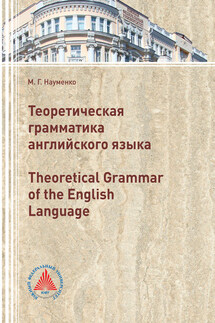Теоретическая грамматика английского языка (Theoretical Grammar of the English language) - страница 4
Levels of Language Units
Units of language are divided into segmental and suprasegmental. Segmental units consist of phonemes, they form phonemic strings of various status. Suprasegmental units do not exist by themselves, but are realized with segmental units and express different modificational meanings reflected on the strings of segmental units (Blokh, 2000).
The segmental units of language form a hierarchy of levels. Units of each higher level are formed of units of the immediately lower level.
Professor M.Ya.Blokh: the of lingual units is phonemic: it is formed by phonemes. The phoneme has no meaning, its function is purely differential. The level, located above the phonemic level, is morphemic. The morpheme is the elementary meaningful part of the word built up by phonemes. The morpheme expresses abstract, "significative", meaning. The level is lexemic. Its differential unit is the word. The word realizes the function of nomination. The level is denotemic, its constituent unit is denoteme (notional part of the sentence). The level is proposemic. It is built up by sentences. As a sign, the sentence simultaneously fulfils two functions – nominative and predicative. The level is the level of topicalization, its constituent element is the "dicteme" ("utterance"). The function of the dicteme is to build up a topical stretch of some text. Being an elementary topical unit of text, the dicteme fulfils four main signemic functions: the functions of nomination, predication, topicalization, and stylization (Blokh, 2000).
The main units of language are considered to be the word and the sentence. Words are studied by morphology, sentences are studied by syntax.
Morphemic Structure of the Word
The word is the nominative unit of language built up by morphemes and indivisible into smaller segments as regards its nominative function (Blokh, 2000). The morphological system of language reveals its properties through the morphemic structure of words. So, it is but natural that one of the essential tasks of morphology is to study the morphemic structure of the word.
In traditional grammar the study of the morphemic structure of the word is based upon two criteria – positional and semantic (functional). The positional criterion presupposes the analysis of the location of the marginal morphemes in relation to the central ones. The semantic criterion involves the study of the correlative contribution of the morpheme to the general meaning of the word. In accord with the traditional classification, morphemes at the upper level are divided into root morphemes and affixal morphemes (lexical and grammatical) (Blokh, 2000).
Synthetic and analytic languages
In , there are synthetic and analytic languages. Synthetic languages compose (synthesize) multiple concepts into each word, while analytic languages break up (analyze) concepts into separate words. The distinction is a matter of degree: the most analytic languages consistently have one morpheme per word while, at the other extreme, in polysynthetic languages, a single inflected verb may contain as much information as an entire English sentence (URL: https://en.wikipedia.org/wiki/Synthetic_language).
The English language refers to the languages of the analytic type. The modern forms of the English verb (are doing, has been studying) are formed analytically, because they consist of a part devoid of lexical meaning and transmitting the required grammatical categories, and a part conveying a semantic meaning (root morphemes: do, run).


